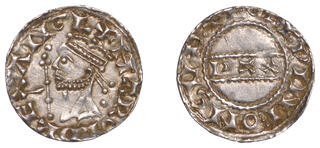| Noonans (formerly Dix Noonan Webb) > Auction 290 | Auction date: 21 February 2024 |
| Lot number: 1095 Price realized: 7,500 GBP (Approx. 9,459 USD / 8,754 EUR) Note: Prices do not include buyer's fees. | Show similar lots on CoinArchives Find similar lots in upcoming auctions on |
| Lot description: Harold II Harold II (1066), PAX type with Sceptre, Penny, Sudbury, Folcwine, Gp B, +harold rex angl, two pellets in field, one above the sceptre head and another behind the neck, small wedge leading from 'X' towards sceptre, rev. +folcpine on svð:, 1.46g/6h (Bt 108, this coin; Parsons –; Pagan, NM –; BMC –). About extremely fine with light hoard patina; the mint previously unrecorded in this reign £3,000-£4,000 --- Struck from the same dies as Braintree 105-7 and 109; the mint not represented in the Chew Valley hoard. The mint of Sudbury was previously unrecorded in the reign of Harold; it is now known from five Pennies, all of which are offered for sale here. It is curious that the obverse die used to strike these coins has been 'marked' by the addition of pellets in the field and a small wedge that leads from the 'X' in the legend to the king's sceptre. The possibility that these marks reflect a deliberate policy is reinforced by the fact that a similar set of marks occur on the only known obverse die to have been used by this moneyer in the preceding type, Pyramids (Braintree 32-5). One option, by no means certain, is that these marks form a rudimentary form of privy-marking. This approach to mint organisation, whereby the design of the dies was deliberately varied as a form of administrative control, manifests itself most clearly in the moneyers' names appearing on the reverse dies used to strike England's coinage from the mid eighth-century onwards. Attempts at more subtle privy marking are, by their very nature, harder to detect. Nevertheless, enough potential examples have been identified to suggest that use of this system was fairly common in Anglo-Saxon England. At the Ipswich mint of Ceolwulf I we find subtle variation in the obverse design which Naismith recognised as an effort 'to distinguish the dies for each moneyer – presumably to prevent them from being interchangeable and thus reinforce the individual basis on which the moneyers worked' (2012, 141). A similar scheme was used at York following Æthelstan's conquest in 927, with coins frequently adorned with various ornaments, appearing most often in obverse field and legend. Blunt saw these ornaments as an 'elaborate form of privy-marking', and it seems likely that their function was to distinguish the dies allocated to the various labourers who assisted the sole moneyer, Ragnaldr, in his work. What then would have been the purpose of privy-marking Folcwine's obverse dies? Perhaps, given the occasional nature of minting at Sudbury, there was a fear that the obverse dies allocated to Folcwine might 'wander off' to be used by some moneyer at nearby mint who required a fresh obverse die, but was keen to avoid paying the necessary seigniorage fees. |  |


